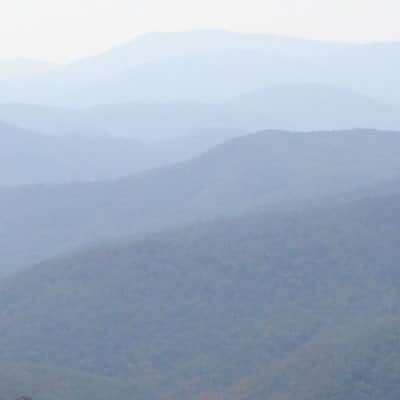Explore North Carolina

Great Smoky Mountains National Park
There are four entrances to the Great Smoky Mountains National Park from the North Carolina, a short drive from our bed and breakfast in Waynesville. Ridge upon ridge of forest straddles the border between North Carolina and Tennessee in Great Smoky Mountains National Park. World renowned for its diversity of plant and animal life, the beauty of its ancient mountains, and the quality of its remnants of Southern Appalachian mountain culture, this is America’s most visited national park. From black bears to salamanders. Old-growth forests to spring wildflowers. Log cabins to grist mills. The Smokies offer a myriad of opportunities for exploring and discovering both the natural and cultural history of these ancient mountains.
Great Smoky Mountains National Park is a hiker’s paradise with over 800 miles of maintained trails ranging from short leg-stretchers to strenuous treks that may require backcountry camping. But hiking is not the only reason for visiting the Smokies. Fishing, picnicking, wildlife viewing and auto touring are popular activities.
Most visitors come to the Smokies hoping to see a bear. Some 1,500 bears live in the park. From the big animals like bears, deer, and elk, down to microscopic organisms, the Smokies have the most biological diversity of any area in the world’s temperate zone. The park is a sanctuary for a magnificent array of animal and plant life, all of which is protected for future generations to enjoy.
Here are the four areas in the Great Smoky Mountains that are closest to our Waynesville bed and breakfast:
Elk at Cataloochee

Less than 20 miles away is the Cataloochee area of the Smokies. The experimental release of elk into Great Smoky Mountains National Park began in 2001 with the importation of 25 elk. In 2002, the park imported another 27 animals. Most of the elk are located in the Cataloochee area in the southeastern section of the park and can often be seen from your car. Access requires driving two miles on a narrow gravel road, but it is well-maintained and passable for standard passenger vehicles. To get there from I-40, exit at North Carolina exit #20. After 0.2 mile, turn right and follow the signs 11 miles into Cataloochee Valley.
Oconaluftee

An easily 27-mile drive from our bed and breakfast is Oconaluftee, offering both a visitor center and the Mountain Farm Museum—a collection of historic log buildings gathered from throughout the Smoky Mountains and preserved on a single site. It’s just a couple of miles outside of Cherokee on U.S. Highway 441, the only road to completely cross the National Park, taking you to Gatlinburg, Tennessee. You should drive up to Newfound Gap to enjoy the views.
At the Oconalutfee visitor center, rangers can answer your questions about the park and there is a bookstore with a broad selection of guides, maps, and other products. The Mountain Farm Museum includes a log farmhouse, barn, apple house, springhouse, and a working blacksmith shop that gives a sense of how families may have lived 100 years ago. Most of the structures were built in the late 19th century and were moved here in the 1950s. The museum is adjacent to the Oconaluftee Visitor Center. Two excellent walking trails start from the vicinity. The Oconaluftee River Trail follows its namesake stream for 1.5 miles to Cherokee. Mingus Creek Trail climbs past old farms to the Smokies high country. The easy, 1.5 mile Oconaluftee River Trail begins near the entrance to the museum.
A half-mile north of the Oconaluftee Visitor Center is Mingus Mill. Built in 1886, this historic grist mill uses a water-powered turbine instead of a water wheel to power all of the machinery in the building. Located at its original site, Mingus Mill stands as a tribute to the test of time. Hours: 9:00 AM – 5:00 PM daily mid-March through mid-November.
A trip over the Newfound Gap Road has often been compared to a drive from Georgia to Maine in terms of the variety of forest ecosystems one experiences. Starting from either Cherokee, travelers climb approximately 3,000 feet as they drive, ascending through cove hardwood, pine-oak, and northern hardwood forest to attain the evergreen spruce-fir forest at Newfound Gap (5,046′).
Temperatures at the gap may be 10° F. or more cooler than in the lowlands and precipitation falling as rain in Cherokee may be snow at Newfound Gap. From the parking area at Newfound Gap you can straddle the state line between North Carolina and Tennessee or take a stroll on the Appalachian Trail, a 2,200 mile footpath running from Georgia to Maine.
Just south of Newfound Gap, the seven-mile Clingmans Dome Road climbs to within 0.5 mile of Clingmans Dome (6,643′), the highest peak in the Smokies (and third highest in the East). From the large parking area at the end of the road, a 0.5-mile trail climbs steeply to an observation tower at the “top of old Smoky.”
Deep Creek

About 35 miles away near Bryson City is the Deep Creek area of the Great Smoky Mountains, celebrated for its streams and waterfalls. Hikers can choose from several loop hikes leading to the waterfalls. Mountain bikers can take advantage of one of the few park trails where bicycles are permitted. Around two miles of walking will acquaint you with beautiful Deep Creek and three pretty waterfalls. Deep Creek area loop hikes include Juney Whank Falls (0.6 mile), Three Waterfalls Loop (2.4 miles), and Deep Creek-Indian Creek Loop (4.4 miles). Longer loop hikes are also possible. Trails to the waterfalls start from the large parking area at the end of Deep Creek Road (across the creek from Deep Creek Campground).
After a day of exploring the Great Smoky Mountains National Park, return to our luxury bed and breakfast accommodations in Waynesville, North Carolina.










